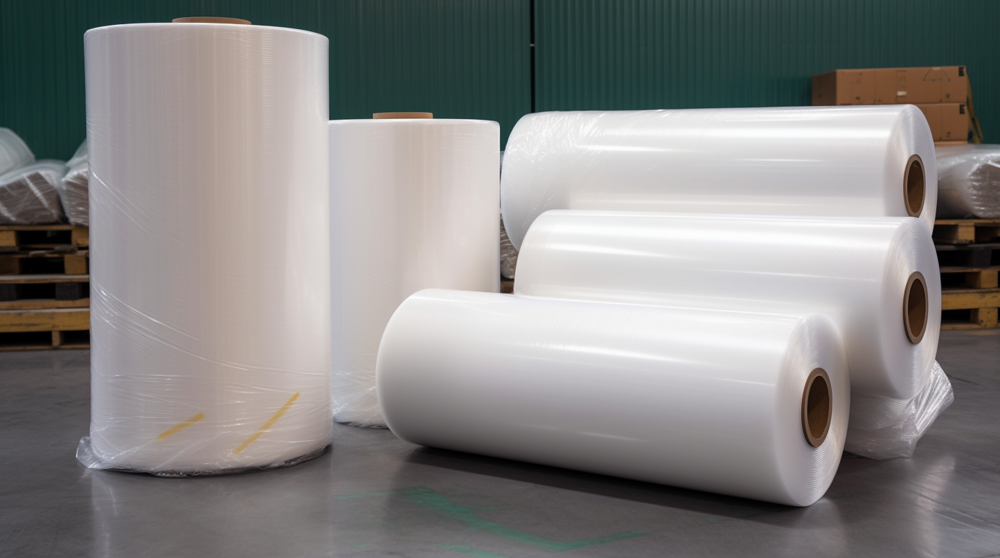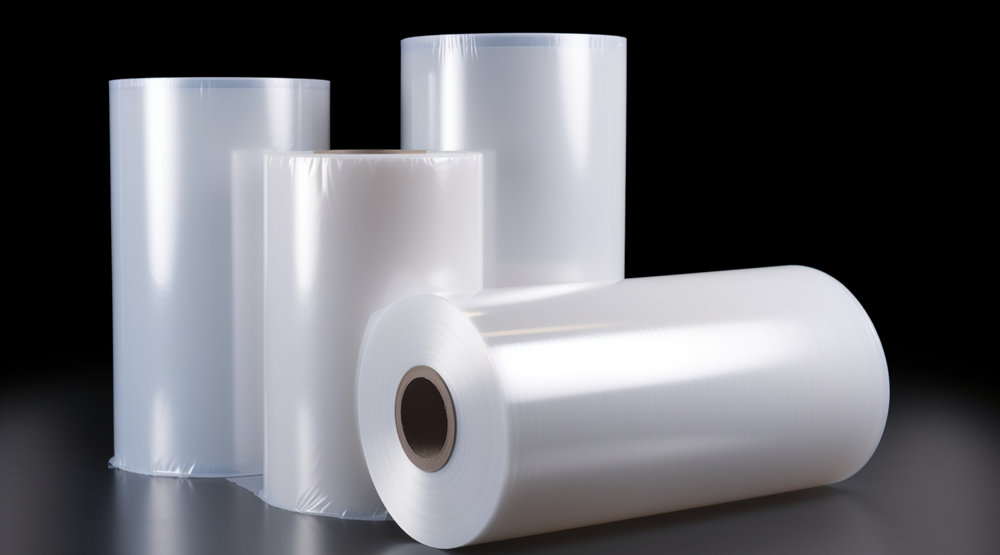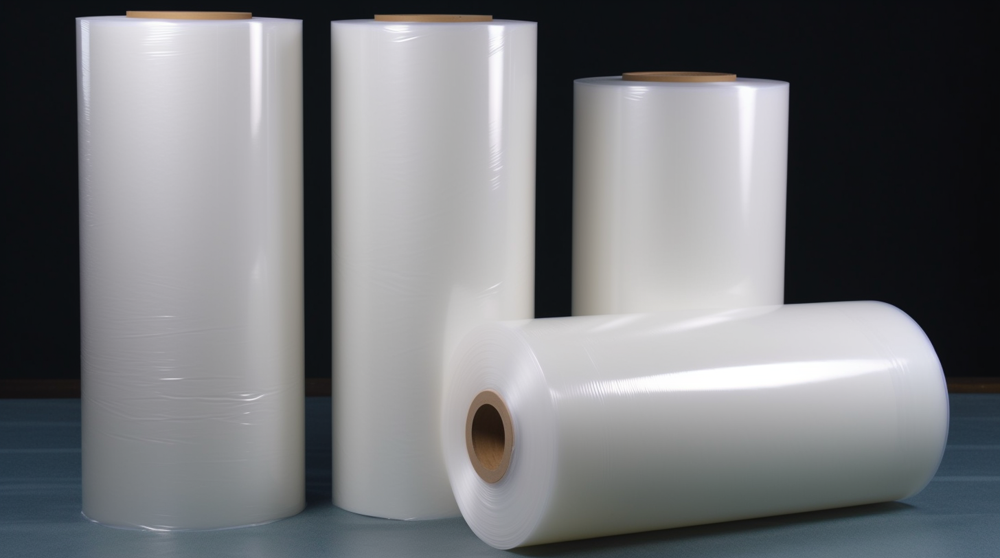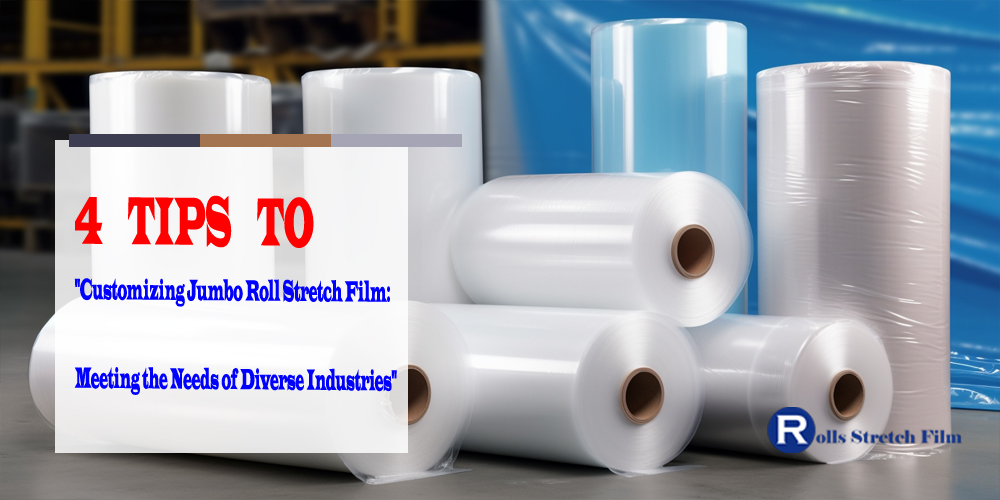Jumbo roll stretch film is a versatile packaging material used across diverse industries, but not all businesses have the same needs. Customizing stretch film to meet specific requirements can help improve efficiency and reduce costs. In this article, we’ll share 4 tips on how to customize jumbo roll stretch film to better meet the needs of your industry.
In customizing jumbo roll stretch film, you need to understand the diverse industry needs including the benefits, drawbacks, and the importance of selecting the right jumbo roll stretch film. Also, know the advantages of these customizations and how to choose a reliable supplier for them.
From selecting the right material and size to incorporating color and print, these tips will help you create packaging that meets your exact requirements.
What is Jumbo Roll Stretch Film?

Jumbo roll stretch film is a type of packaging material made from linear low-density polyethylene (LLDPE) that is used to wrap and secure products on pallets or for bundling items together. It is called “jumbo” because it is typically sold in large rolls that are several feet wide and thousands of feet long.
Jumbo roll stretch film specification table
| Specification | Description |
|---|---|
| Material | Polyethylene (PE) |
| Thickness | 8-35 microns |
| Width | 30-75 mm |
| Weight | 10-50 kg |
| Color | Transparent or customized |
| Core size | Standard or customized |
4 Tips to “Customizing Jumbo Roll Stretch Film: Meeting the Needs of Diverse Industries”
1. Understanding Diverse Industry Needs for Jumbo Roll Stretch Film
Overview of different industries that use stretch film
Here’s an overview of some of the industries that use stretch film:
- Manufacturing and Distribution: Manufacturing and distribution companies use stretch film to secure products on pallets during transport and storage. It provides a protective layer around the products and prevents them from shifting or falling off the pallet.
- Food and Beverage: The food and beverage industry uses stretch film to wrap and protect perishable items, such as fresh produce, meat, and dairy products. It helps to maintain the freshness and quality of the food while also providing a barrier against contaminants.
- Retail: Retail stores use stretch film to bundle products together and prevent them from being separated or damaged during transit. It is also used to wrap and protect fragile items, such as glassware or electronics, during shipping.
- E-commerce: With the rise of e-commerce, stretch film has become an essential packaging material for online retailers. It is used to wrap and secure items in boxes or envelopes, protecting them from damage during shipping.
- Healthcare: The healthcare industry uses stretch film to wrap and protect medical equipment, such as syringes, catheters, and surgical instruments. It helps to maintain the sterility of the equipment and prevents contamination.
Discussion of various requirements such as sizes, thickness, cling, UV protection, color, and more
Here’s a closer look at some of the key factors that can be customized:
- Sizes: Jumbo roll stretch film is available in different sizes, from narrow widths to several feet wide, to fit different products and pallet sizes.
- Thickness: The thickness of the stretch film can be customized to meet specific requirements, depending on the weight and fragility of the products being wrapped. Thicker films provide more protection, while thinner films offer cost savings.
- Cling: Cling is the ability of the stretch film to stick to itself without the need for additional adhesive. Different cling levels are available, depending on the application requirements.
- UV protection: For products that are exposed to sunlight or outdoor conditions, UV-resistant stretch film can be used to protect against damage from UV rays.
- Color: Stretch film can be customized in different colors to help with identification, and branding, or to comply with industry regulations.
- Print: Custom printing on stretch film is also available to include branding, product information, or warning messages.
- Core size: The core size of jumbo roll stretch film can be customized to fit specific dispensers or machines.
- Pre-stretch: Pre-stretched stretch film can be used to reduce the amount of film required for each application, leading to cost savings.
Examples of unique industry demands such as food-grade, medical-grade, or heavy-duty applications
Here are some examples of unique industry demands for jumbo roll stretch film:
- Food-grade: Jumbo roll stretch film used in the food industry must be food-grade, which means it is made of materials that are safe for food contact and do not contaminate the food. The film must also have good barrier properties to protect the food from moisture, oxygen, and other contaminants.
- Medical-grade: Jumbo roll stretch film used in medical applications must meet the requirements and must also be compatible with various sterilization methods such as gamma radiation, ethylene oxide, or autoclaving.
- Heavy-duty: Some industries require jumbo roll stretch film that can withstand heavy loads and rough handling. For example, the construction industry uses stretch film to wrap building materials such as lumber, pipes, and steel beams. In this application, the film must be strong, tear-resistant, and able to hold the load securely in place during transport and storage.
2. Customization Options for Jumbo Roll Stretch Film
A detailed explanation of different customization options available for stretch films
Here are some of the customization options available for jumbo roll stretch films:
- Film Thickness: The thickness of the film determines its strength and durability. Jumbo roll stretch films come in different thicknesses, ranging from 6 microns to 30 microns or more. The thinner films are used for lighter loads, while thicker films are used for heavier loads or for products that require extra protection during transit.
- Film Width: The width of the film determines the amount of coverage it provides. Jumbo roll stretch films come in different widths, ranging from 12 inches to 80 inches or more. The wider films are used for larger products or for wrapping multiple items together.
- Film Color: The color of the film can be customized to meet specific branding or identification needs. Jumbo roll stretch films come in different colors, including clear, opaque, black, and colored films.
- Film Material: The material used in the production of the film can be customized to meet specific needs, such as resistance to moisture, UV rays, or punctures. Jumbo roll stretch films can be made from various materials, including LLDPE (Linear Low-Density Polyethylene), LDPE (Low-Density Polyethylene), and PVC (Polyvinyl Chloride).
- Adhesive Strength: The adhesive strength of the film can be customized to meet specific packaging needs. Jumbo roll stretch films come in different adhesive strengths, ranging from low-tack to high-tack films. Low-tack films are used for delicate products, while high-tack films are used for heavy or irregularly shaped products.
- Roll Length: The length of the jumbo roll can be customized to meet specific packaging needs. Jumbo roll stretch films come in different lengths, ranging from 1,000 feet to 10,000 feet or more. Longer rolls are used for larger volume packaging needs, while shorter rolls are used for smaller volume needs.
Discussing the benefits and drawbacks of each option
Film Thickness:
Benefits: Choosing the right thickness ensures that the packaging material provides adequate protection during transportation and storage. Thicker films are more durable and less likely to tear or puncture during handling, while thinner films are more economical and flexible, making them easier to wrap around products.
Drawbacks: Thicker films are more expensive than thinner films and may not be necessary for all packaging needs. Additionally, thicker films may be less environmentally friendly as they require more raw materials and take longer to decompose.
Film Width:
Benefits: Choosing the right width ensures that the packaging material covers the entire product, providing maximum protection against damage during transportation and storage. Wider films are ideal for larger products or for wrapping multiple products together, which can reduce packaging time and increase efficiency.
Drawbacks: Wider films may be more difficult to handle and require more storage space, increasing storage costs. Additionally, wider films may be less cost-effective for smaller products, as they require more material to cover the same area.
Film Color:
Benefits: Choosing the right color can help identify products, improve branding, and add aesthetic value to the packaging. Clear films are ideal for showcasing products, while opaque and colored films can help hide the contents of the package, improving security during transportation and storage.
Drawbacks: Colored and opaque films may be more expensive than clear films, and may require more storage space as they are often sold in smaller quantities. Additionally, colored and opaque films may be less environmentally friendly as they require additional dyeing and coloring processes.
Film Material:
Benefits: Choosing the right material ensures that the packaging material is resistant to specific environmental factors such as moisture, UV rays, or punctures. Each material offers unique properties that can be customized to meet specific packaging needs.
Drawbacks: Different materials have different costs, and some materials may not be environmentally friendly, which may be a concern for businesses looking to reduce their environmental impact.
Adhesive Strength:
Benefits: Choosing the right adhesive strength ensures that the packaging material adheres well to the product, providing maximum protection during transportation and storage. Low-tack films are ideal for delicate products, while high-tack films are ideal for heavy or irregularly shaped products.
Drawbacks: Different adhesive strengths have different costs, and some adhesives may leave residue on products or packaging equipment, which may be difficult to remove.
Roll Length:
Benefits: Choosing the right roll length ensures that businesses purchase the appropriate amount of packaging material for their needs, reducing waste and lowering costs. Longer rolls are ideal for larger volume packaging needs, while shorter rolls are ideal for smaller volume needs.
Drawbacks: Longer rolls may require more storage space and may be more difficult to handle during transportation and storage. Additionally, longer rolls may be less cost-effective for smaller packaging needs, as businesses may not use the entire roll before it reaches its expiration date.

Highlighting the importance of selecting the right customization option based on industry needs
Selecting the right customization options for jumbo roll stretch films is essential for ensuring that the packaging material provides adequate protection during transportation and storage. Different industries have unique packaging needs, and selecting the right customization options can help businesses optimize their packaging operations while reducing costs and waste.
3. Advantages of Customization of Jumbo Roll Stretch Film
Jumbo roll stretch film advantages table
| Advantage | Description |
|---|---|
| Cost-effective | Jumbo roll stretch film can reduce the material and labor costs by using less film per load and increasing the wrapping efficiency. |
| High performance | Jumbo roll stretch film has high tensile strength, puncture resistance, cling, and stretchability, which can ensure the load stability and security during transit and storage. |
| Environmentally friendly | Jumbo roll stretch film is 100% recyclable and biodegradable, which can reduce the environmental impact of plastic waste. |
| Customizable | Jumbo roll stretch film can be customized according to the customer’s requirements, such as color, size, thickness, printing, etc. |
How customizing stretch film can help improve product quality, reduce waste, and save money
Customizing stretch film allows businesses to select the right film thickness, material, and adhesive strength, ensuring that their products are well-protected during transportation and storage. This can help reduce damage to products, improve their overall quality, and minimize the need for costly repairs or replacements. Selecting the right film width and roll length can help businesses optimize their use of packaging materials, reducing waste and saving money.
Examples of how the customized stretch film has helped industries operate more efficiently
- In the manufacturing industry, customized jumbo roll stretch film has helped businesses reduce product damage during transportation and storage, which can result in costly repairs or replacements.
- In the food industry, customized jumbo roll stretch film has helped businesses meet strict safety and hygiene requirements, while also improving product quality and shelf life.
- In the retail industry, customized jumbo roll stretch film has helped businesses enhance their branding and marketing efforts, while also improving the appearance of their products.
- In the logistics industry, customized jumbo roll stretch film has helped businesses improve operational efficiency and reduce costs.
4. Choosing a Reliable Supplier for Jumbo Roll Stretch Film
Importance of choosing a supplier who has expertise in customizing stretch film
Choosing a supplier with expertise in customizing jumbo roll stretch film can help businesses optimize their packaging operations, improve product quality and protection, reduce waste, save costs, and enhance their overall brand image.
Factors to consider when selecting a supplier such as an experience, production capabilities, certifications, customer service, and more
Here are some factors to consider when selecting a supplier:
- Experience: Look for a supplier with a proven track record of providing high-quality custom packaging solutions. An experienced supplier will be able to provide expert advice on the most suitable customization options based on the specific needs of your business.
- Production capabilities: Choose a supplier with the necessary resources and capabilities to produce custom jumbo roll stretch film to meet your unique requirements. This includes having a wide range of film materials, thicknesses, widths, and adhesive strengths available.
- Certifications: Ensure that your supplier has the necessary certifications to meet industry standards and regulations. This includes certifications such as ISO 9001, which ensures that the supplier has a quality management system in place.
- Customer service: Look for a supplier that provides excellent customer service, including responsive communication, timely delivery, and a willingness to work with you to meet your specific needs.
- Cost-effectiveness: Choose a supplier that offers competitive pricing without compromising on quality. Look for a supplier that can help you optimize your packaging processes to reduce waste and save costs.
- Sustainability: Consider choosing a supplier that has a commitment to sustainability and offers eco-friendly packaging solutions. This can help you appeal to eco-conscious customers and reduce your environmental impact.
- Reputation: Look for a supplier with a good reputation in the industry. Check online reviews and ask for references from other businesses that have worked with the supplier.

Customizing jumbo roll stretch film can help businesses across diverse industries optimize their packaging operations, reduce waste, and save costs. Considering the specific needs of their industry, selecting the right customization options, and working with an experienced supplier can provide valuable guidance and resources for businesses looking to customize their packaging solutions effectively.














